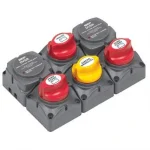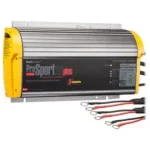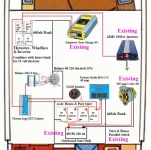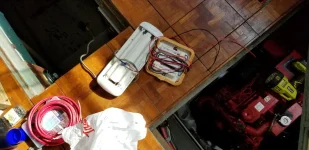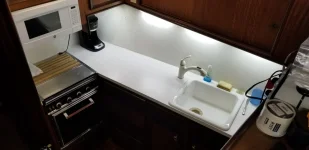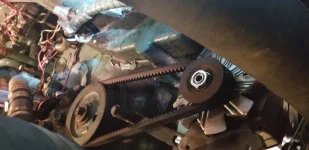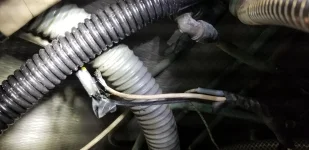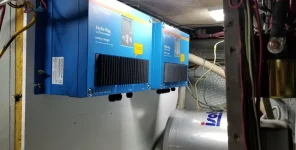Jammin'
Well-known member
- Joined
- Jan 3, 2018
- Messages
- 479
- Status
- OWNER - I own a Hatteras Yacht
- Hatteras Model
- 43' DOUBLE CABIN (1970 - 1984)
I'm a little nervous coming out electrically here, so to speak, so go easy on me. I am planning a modest upgrade to our battery and charging system. I have attached a diagram that shows approximately where things are and will be located in the engine room of our 43DC.
The inverter set up is a little different than most. I have one duplex outlet next to the refrigerator. To use the inverter, you physically plug in what you want to use. This system is fine with me. We need nothing more complicated. It is currently used for the refrigerator while under way, a coffee pot, or a microwave, or a toaster oven. It was previously hooked up to the single 8D for the thruster and windlass. We promptly fried that battery and the alternator on the port side on our trip up here. Not enough capacity and no way to monitor it. Eventually we may go to a 12 volt refrigerator to reduce the load on the inverter.
In the illustrated set-up, we would have one AGM house bank with a modest capacity of 440ah and a battery monitor to keep track of usage. All DC loads except the thruster (well, half of the thruster as it combines with this bank for 24 volts), windlass and starboard starter would be hooked to this bank. This bank would be charged off the new 120 amp externally regulated Balmer alternator, derated by 15% so as not to overload the single 1/2" V-belt, and off the 60 amp leg of the Skylla charger. The alternator would be spinning at approximately 3150 rpm at our 1400 rpm cruise engine speed.
The battery to aft would be a dedicated FLA starting battery for the starboard engine only and charged by the starboard engine alternator and the 3 amp leg off the Skylla charger. We have a combining solenoid for the starting and house banks should we draw down the house bank too far to start the port engine.
The thruster/windlass battery would be an AGM 4D. AGM because it is really difficult to get to for maintenance. The minimum capacity required for the thruster is listed as 150ah in the manual. This battery would be charged off the port engine 120 amp alternator and off one leg of the existing Statpower 40 amp charger.
For the next couple of years, we'll be fixing up the boat for our intended usage of cruising to Florida and the Bahamas when we retire. Maybe farther. Maybe further. Any suggestions on how to make this system better and/or simpler?
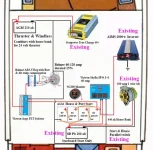
The inverter set up is a little different than most. I have one duplex outlet next to the refrigerator. To use the inverter, you physically plug in what you want to use. This system is fine with me. We need nothing more complicated. It is currently used for the refrigerator while under way, a coffee pot, or a microwave, or a toaster oven. It was previously hooked up to the single 8D for the thruster and windlass. We promptly fried that battery and the alternator on the port side on our trip up here. Not enough capacity and no way to monitor it. Eventually we may go to a 12 volt refrigerator to reduce the load on the inverter.
In the illustrated set-up, we would have one AGM house bank with a modest capacity of 440ah and a battery monitor to keep track of usage. All DC loads except the thruster (well, half of the thruster as it combines with this bank for 24 volts), windlass and starboard starter would be hooked to this bank. This bank would be charged off the new 120 amp externally regulated Balmer alternator, derated by 15% so as not to overload the single 1/2" V-belt, and off the 60 amp leg of the Skylla charger. The alternator would be spinning at approximately 3150 rpm at our 1400 rpm cruise engine speed.
The battery to aft would be a dedicated FLA starting battery for the starboard engine only and charged by the starboard engine alternator and the 3 amp leg off the Skylla charger. We have a combining solenoid for the starting and house banks should we draw down the house bank too far to start the port engine.
The thruster/windlass battery would be an AGM 4D. AGM because it is really difficult to get to for maintenance. The minimum capacity required for the thruster is listed as 150ah in the manual. This battery would be charged off the port engine 120 amp alternator and off one leg of the existing Statpower 40 amp charger.
For the next couple of years, we'll be fixing up the boat for our intended usage of cruising to Florida and the Bahamas when we retire. Maybe farther. Maybe further. Any suggestions on how to make this system better and/or simpler?


